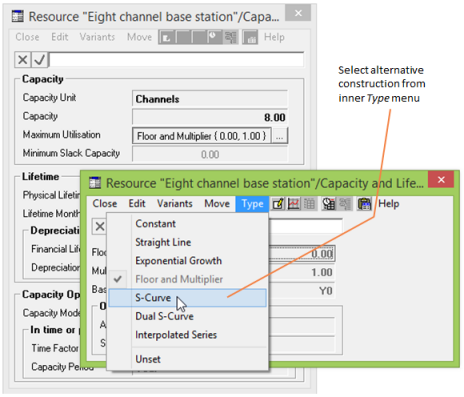Many of the input data in a STEM model can be described as time series. STEM provides a number of alternative constructions, which allow you to provide a concise specification for the evolution of a time series, without necessarily having to specify an explicit value for each year or period of the model run. For example, you can specify a time series as a simple Constant, or as an Exponential Growth or S-Curve. Alternatively, you can provide values for specific years or periods in an Interpolated Series – see 10.3.33 Time-series inputs.
In the STEM Editor, a time series is summarised in a single cell within a data dialog. When that field is selected, a small button appears at the right of the cell. You can left-click this button (or right-click the cell for more options from a local context menu) to edit the parameters of a particular construction. Each construction requires a different set of inputs, so the dialog for the inner fields has an additional Type menu which allows you to change from one construction to another. Alternatively, you can pick an alternative construction from the Type cascading sub-menu within the original context menu.

Time-series Type menu
When you change type, STEM copies the previous data into the alternative construction, where there is a natural match, and discards the remaining values. For example, the
Base of an Exponential Growth is carried through to the Saturation of an S-Curve, but there is no natural match for the Multiplier, which is therefore discarded.
There is an additional Unset item on the Type menu, which returns the time series to its default construction and values. This only affects the inner fields and does not remove any (button) formula for the whole time series.
The Find function can be used to search for text in values and formulae throughout the model – see 4.21.1 Finding elements, text and values.